The Influence of Plasticizers and Accelerated Ageing on Biodegradation of PLA under Controlled Composting Conditions
Abstract
1. Introduction
2. Materials and Methods
2.1. Preparation of PLA Films
2.2. Accelerated Ageing
2.3. Mechanical Properties
2.4. Rheological Properties
2.5. Analysis of Biodegradability under Thermophilic Composting
2.6. Differential Scanning Calorimetry (DSC)
2.7. Fourier Transform Infrared Spectroscopy (FT-IR)
2.8. Thermogravimetric Analysis (TGA)
2.9. Scanning Electron Microscopy (SEM) Analysis
3. Results
3.1. Mechanical Properties
3.2. Rheological Properties
3.3. Differential Scanning Calorimetry (DSC)
3.4. Thermogravimetric Analysis (TGA)
3.5. Scanning Electron Microscopy (SEM) Analysis
3.6. Fourier Transform Infrared Spectroscopy (FT-IR)
3.7. Degree of Disintegration of Composted PLA Films
3.8. Biodegradability under Thermophilic Composting
4. Conclusions
Supplementary Materials
Author Contributions
Funding
Institutional Review Board Statement
Informed Consent Statement
Data Availability Statement
Conflicts of Interest
References
- Plastic-the Facts 2021. [online]. B.m.: Plastic Europe Association of Plastic Manufactures. 2021. Available online: http://plasticseurope.org/knowledge-hub/plastics-the-facts-2021 (accessed on 1 September 2022).
- Hao, Y.; Shafer, G. Models for Predicting Global Plastic Waste. Aresty RURJ 2021, 1, 57–61. [Google Scholar] [CrossRef]
- Becker, N.; Siebert-Raths, A. Biopolymers Facts and Statistics 2021; Hochschule Hannover: Hannover, Germany, 2021. [Google Scholar]
- Rahman, M.; Brazel, C.S. The Plasticizer Market: An Assessment of Traditional Plasticizers and Research Trends to Meet New Challenges. Prog. Polym. Sci. 2004, 29, 1223–1248. [Google Scholar] [CrossRef]
- Vieira, M.G.A.; da Silva, M.A.; dos Santos, L.O.; Beppu, M.M. Natural-Based Plasticizers and Biopolymer Films: A Review. Eur. Polym. J. 2011, 47, 254–263. [Google Scholar] [CrossRef]
- Jacobsen, S.; Fritz, H.-G. Plasticizing Polylactide—the Effect of Different Plasticizers on the Mechanical Properties. Polym. Eng. Sci. 1999, 39, 1303–1310. [Google Scholar] [CrossRef]
- Al-Mulla, E.A.J.; Yunus, W.M.; Wan, Z.; Ibrahim, N.A.B.; Rahman, M.Z.A. Properties of Epoxidized Palm Oil Plasticized Polytlactic Acid. J. Mater. Sci. 2010, 45, 1942–1946. [Google Scholar] [CrossRef]
- Carbonell-Verdu, A.; Samper, M.D.; Garcia-Garcia, D.; Sanchez-Nacher, L.; Balart, R. Plasticization Effect of Epoxidized Cottonseed Oil (ECSO) on Poly (Lactic Acid). Ind. Crop. Prod. 2017, 104, 278–286. [Google Scholar] [CrossRef]
- Ljungberg, N.; Wesslen, B. Tributyl Citrate Oligomers as Plasticizers for Poly (Lactic Acid): Thermo-Mechanical Film Properties and Aging. Polym. J. 2003, 44, 7679–7688. [Google Scholar] [CrossRef]
- Maiza, M.; Benaniba, M.T.; Quintard, G.; Massardier-Nageotte, V. Biobased Additive Plasticizing Polylactic Acid (PLA). Polimeros 2015, 25, 581–590. [Google Scholar] [CrossRef]
- Hassouna, F.; Raquez, J.-M.; Addiego, F.; Dubois, P.; Toniazzo, V.; Ruch, D. New Approach on the Development of Plasticized Polylactide (PLA): Grafting of Poly (Ethylene Glycol)(PEG) via Reactive Extrusion. Eur. Polym. J. 2011, 47, 2134–2144. [Google Scholar] [CrossRef]
- Darie-Niţă, R.N.; Vasile, C.; Irimia, A.; Lipşa, R.; Râpă, M. Evaluation of Some Eco-friendly Plasticizers for PLA Films Processing. J. Appl. Polym. Sci. 2016, 133, 43223. [Google Scholar] [CrossRef]
- Chieng, B.W.; Azowa, I.N.; Yunus, W.; Wan, M.Z.; Hussein, M.Z. Effects of Graphene Nanopletelets on Poly (Lactic Acid)/Poly (Ethylene Glycol) Polymer Nanocomposites. In Proceedings of the Advanced Materials Research; Trans Tech Publications: Zürich, Switzerland, 2014; Volume 1024, pp. 136–139. [Google Scholar]
- Courgneau, C.; Domenek, S.; Guinault, A.; Avérous, L.; Ducruet, V. Analysis of the Structure-Properties Relationships of Different Multiphase Systems Based on Plasticized Poly (Lactic Acid). J. Polym. Environ. 2011, 19, 362–371. [Google Scholar] [CrossRef]
- Sessini, V.; Palenzuela, M.; Damián, J.; Mosquera, M.E. Bio-Based Polyether from Limonene Oxide Catalytic ROP as Green Polymeric Plasticizer for PLA. Polym. J. 2020, 210, 123003. [Google Scholar] [CrossRef]
- Kodal, M.; Sirin, H.; Ozkoc, G. Long-and Short-Term Stability of Plasticized Poly (Lactic Acid): Effects of Plasticizers Type on Thermal, Mechanical and Morphological Properties. Polym. Bull. 2019, 76, 423–445. [Google Scholar] [CrossRef]
- Tsou, C.-H.; Suen, M.-C.; Yao, W.-H.; Yeh, J.-T.; Wu, C.-S.; Tsou, C.-Y.; Chiu, S.-H.; Chen, J.-C.; Wang, R.Y.; Lin, S.-M. Preparation and Characterization of Bioplastic-Based Green Renewable Composites from Tapioca with Acetyl Tributyl Citrate as a Plasticizer. Materials 2014, 7, 5617–5632. [Google Scholar] [CrossRef]
- Burgos, N.; Martino, V.P.; Jiménez, A. Characterization and Ageing Study of Poly (Lactic Acid) Films Plasticized with Oligomeric Lactic Acid. Polym. Degrad. Stab. 2013, 98, 651–658. [Google Scholar] [CrossRef]
- Itävaara, M.; Karjomaa, S.; Selin, J.-F. Biodegradation of Polylactide in Aerobic and Anaerobic Thermophilic Conditions. Chemosphere 2002, 46, 879–885. [Google Scholar] [CrossRef]
- Kale, G.; Kijchavengkul, T.; Auras, R.; Rubino, M.; Selke, S.E.; Singh, S.P. Compostability of Bioplastic Packaging Materials: An Overview. Macromol. Biosci. 2007, 7, 255–277. [Google Scholar] [CrossRef]
- Kolstad, J.J.; Vink, E.T.; De Wilde, B.; Debeer, L. Assessment of Anaerobic Degradation of IngeoTM Polylactides under Accelerated Landfill Conditions. Polym. Degrad. Stab. 2012, 97, 1131–1141. [Google Scholar] [CrossRef]
- Ren, Y.; Hu, J.; Yang, M.; Weng, Y. Biodegradation Behavior of Poly (Lactic Acid)(PLA), Poly (Butylene Adipate-Co-Terephthalate)(PBAT), and Their Blends under Digested Sludge Conditions. J. Polym. Environ. 2019, 27, 2784–2792. [Google Scholar] [CrossRef]
- Poly(ethylene glycol) Product Specification (Product Number 202398). [online]. B.m.: Merck KGaA, Darmstadt, Germany. 2022. Available online: http://www.sigmaaldrich.com (accessed on 1 March 2022).
- Sequeira, M.C.; Pereira, M.F.; Avelino, H.M.; Caetano, F.J.; Fareleira, J.M. Viscosity Measurements of Poly (Ethyleneglycol) 400 [PEG 400] at Temperatures from 293 K to 348 K and at Pressures up to 50 MPa Using the Vibrating Wire Technique. Fluid Phase Equilib. 2019, 496, 7–16. [Google Scholar] [CrossRef]
- Wypych, A. Databook of Plasticizers; Elsevier: Amsterdam, The Netherlands, 2017; ISBN 1-927885-15-9. [Google Scholar]
- Citroflex A-4 Data Sheet. [online]. B.m.: Special Chem. 2022. Available online: http://polymer-additives.specialchem.com/product/a-vertellus-specialties-citroflex-a4 (accessed on 10 January 2022).
- Gibbons, W.S.; Kusy, R.P. Influence of Plasticizer Configurational Changes on the Dielectric Characteristics of Highly Plasticized Poly (Vinyl Chloride). Polym. J. 1998, 39, 3167–3178. [Google Scholar] [CrossRef]
- MC 2178 Technical Data Sheet. [online]. B.m.: Emery Oleochemicals. 2022. Available online: http://greenpolymeradditives.emeryoleo.com (accessed on 15 January 2022).
- MC 2192 Technical Data Sheet. [online]. B.m.: Emery Oleochemicals. 2022. Available online: http://greenpolymeradditives.emeryoleo.com (accessed on 15 January 2022).
- Average Values of Air [online]. Available online: http://www.qpro.cz/Prumerny-stav-vzduchu-dle-vyberu-hodin (accessed on 1 October 2022).
- Râpă, M.; Miteluţ, A.C.; Tănase, E.E.; Grosu, E.; Popescu, P.; Popa, M.E.; Rosnes, J.T.; Sivertsvik, M.; Darie-Niţă, R.N.; Vasile, C. Influence of Chitosan on Mechanical, Thermal, Barrier and Antimicrobial Properties of PLA-Biocomposites for Food Packaging. Compos. Part B Eng. 2016, 102, 112–121. [Google Scholar] [CrossRef]
- Gálvez, J.; Correa Aguirre, J.P.; Hidalgo Salazar, M.A.; Vera Mondragón, B.; Wagner, E.; Caicedo, C. Effect of Extrusion Screw Speed and Plasticizer Proportions on the Rheological, Thermal, Mechanical, Morphological and Superficial Properties of PLA. Polymers 2020, 12, 2111. [Google Scholar] [CrossRef] [PubMed]
- Greco, A.; Ferrari, F. Thermal Behavior of PLA Plasticized by Commercial and Cardanol-Derived Plasticizers and the Effect on the Mechanical Properties. J. Therm. Anal. Calorim. 2021, 146, 131–141. [Google Scholar] [CrossRef]
- Aliotta, L.; Vannozzi, A.; Panariello, L.; Gigante, V.; Coltelli, M.-B.; Lazzeri, A. Sustainable Micro and Nano Additives for Controlling the Migration of a Biobased Plasticizer from PLA-Based Flexible Films. Polymers 2020, 12, 1366. [Google Scholar] [CrossRef]
- Rapa, M.; Darie-Nita, R.N.; Irimia, A.M.; Sivertsvik, M.; Rosnes, J.T.; Trifoi, A.R.; Vasile, C.; Tanase, E.E.; Gherman, T.; Popa, M.E. Comparative Analysis of Two Bioplasticizers Used to Modulate the Properties of PLA Biocomposites. Mater. Plast. 2017, 54, 610–615. [Google Scholar] [CrossRef]
- Hu, Y.; Rogunova, M.; Topolkaraev, V.; Hiltner, A.; Baer, E. Aging of Poly (Lactide)/Poly (Ethylene Glycol) Blends. Part 1. Poly (Lactide) with Low Stereoregularity. Polym. J. 2003, 44, 5701–5710. [Google Scholar] [CrossRef]
- Hu, Y.; Hu, Y.S.; Topolkaraev, V.; Hiltner, A.; Baer, E. Aging of Poly (Lactide)/Poly (Ethylene Glycol) Blends. Part 2. Poly (Lactide) with High Stereoregularity. Polym. J. 2003, 44, 5711–5720. [Google Scholar] [CrossRef]
- Farah, S.; Anderson, D.G.; Langer, R. Physical and Mechanical Properties of PLA, and Their Functions in Widespread Applications—A Comprehensive Review. Adv. Drug Deliv. Rev. 2016, 107, 367–392. [Google Scholar] [CrossRef]
- Rafie, M.A.F.; Marsilla, K.K.; Hamid, Z.A.A.; Rusli, A.; Abdullah, M.K. Enhanced Mechanical Properties of Plasticized Polylactic Acid Filament for Fused Deposition Modelling: Effect of in Situ Heat Treatment. Prog. Rubber Plast. Rcycl. Technol. 2020, 36, 131–142. [Google Scholar] [CrossRef]
- Brdlík, P.; Borůvka, M.; Běhálek, L.; Lenfeld, P. Biodegradation of Poly (Lactic Acid) Biocomposites under Controlled Composting Conditions and Freshwater Biotope. Polymers 2021, 13, 594. [Google Scholar] [CrossRef] [PubMed]
- Wu, H.; Nagarajan, S.; Zhou, L.; Duan, Y.; Zhang, J. Synthesis and Characterization of Cellulose Nanocrystal-Graft-Poly (D-Lactide) and Its Nanocomposite with Poly (L-Lactide). Polym. J. 2016, 103, 365–375. [Google Scholar] [CrossRef]
- Jiménez, A.; Peltzer, M.; Ruseckaite, R. Poly (Lactic Acid) Science and Technology: Processing, Properties, Additives and Applications; Royal Society of Chemistry: London, UK, 2014; ISBN 1-84973-879-3. [Google Scholar]
- Erceg, M.; KovaČiĆ, T.; KlariĆ, I. Thermal Degradation of Poly (3-Hydroxybutyrate) Plasticized with Acetyl Tributyl Citrate. Polym. Degrad. Stab. 2005, 90, 313–318. [Google Scholar] [CrossRef]
- Arrieta, M.P.; Samper, M.D.; López, J.; Jiménez, A. Combined Effect of Poly (Hydroxybutyrate) and Plasticizers on Polylactic Acid Properties for Film Intended for Food Packaging. J. Polym. Environ. 2014, 22, 460–470. [Google Scholar] [CrossRef]
- Arrieta, M.P.; López, J.; Rayón, E.; Jiménez, A. Disintegrability under Composting Conditions of Plasticized PLA–PHB Blends. Polym. Degrad. Stab. 2014, 108, 307–318. [Google Scholar] [CrossRef]
- Gorrasi, G.; Pantani, R. Hydrolysis and Biodegradation of Poly (Lactic Acid). In Synthesis, Structure and Properties of Poly (Lactic Acid); Springer: Cham, Switzerland, 2017; pp. 119–151. [Google Scholar]
- Amorin, N.S.; Rosa, G.; Alves, J.F.; Gonçalves, S.P.; Franchetti, S.M.; Fechine, G.J. Study of Thermodegradation and Thermostabilization of Poly (Lactide Acid) Using Subsequent Extrusion Cycles. J. App. Polym. Sci. 2014, 131, 40023. [Google Scholar] [CrossRef]
- Weng, Y.-X.; Wang, L.; Zhang, M.; Wang, X.-L.; Wang, Y.-Z. Biodegradation Behavior of P (3HB, 4HB)/PLA Blends in Real Soil Environments. Polym. Test. 2013, 32, 60–70. [Google Scholar] [CrossRef]
- Lee, J.C.; Moon, J.H.; Jeong, J.-H.; Kim, M.Y.; Kim, B.M.; Choi, M.-C.; Kim, J.R.; Ha, C.-S. Biodegradability of Poly (Lactic Acid)(PLA)/Lactic Acid (LA) Blends Using Anaerobic Digester Sludge. Macromol. Res. 2016, 24, 741–747. [Google Scholar] [CrossRef]
- Zaidi, L.; Kaci, M.; Bruzaud, S.; Bourmaud, A.; Grohens, Y. Effect of Natural Weather on the Structure and Properties of Polylactide/Cloisite 30B Nanocomposites. Polym. Degrad. Stab. 2010, 95, 1751–1758. [Google Scholar] [CrossRef]
- Vasile, C.; Pamfil, D.; Râpă, M.; Darie-Niţă, R.N.; Mitelut, A.C.; Popa, E.E.; Popescu, P.A.; Draghici, M.C.; Popa, M.E. Study of the Soil Burial Degradation of Some PLA/CS Biocomposites. Compos. Part B Eng. 2018, 142, 251–262. [Google Scholar] [CrossRef]
- Oliveira, M.; Santos, E.; Araújo, A.; Fechine, G.J.; Machado, A.V.; Botelho, G. The Role of Shear and Stabilizer on PLA Degradation. Polym. Test. 2016, 51, 109–116. [Google Scholar] [CrossRef]
- Kammoun, M.; Haddar, M.; Kallel, T.K.; Dammak, M.; Sayari, A. Biological Properties and Biodegradation Studies of Chitosan Biofilms Plasticized with PEG and Glycerol. Int. J. Biol. Macromol. 2013, 62, 433–438. [Google Scholar] [CrossRef] [PubMed]
- Aitor, L.; Erlantz, L. A Review on the Thermomechanical Properties and Biodegradation Behaviour of Polyester. Eur. Polym. J. 2019, 121, 109296. [Google Scholar]
- Salomez, M.; George, M.; Fabre, P.; Touchaleaume, F.; Cesar, G.; Lajarrige, A.; Gastaldi, E. A Comparative Study of Degradation Mechanisms of PHBV and PBSA under Laboratory-Scale Composting Conditions. Polym. Degrad. Stab. 2019, 167, 102–113. [Google Scholar] [CrossRef]
- Cao, N.; Yang, X.; Fu, Y. Effects of Various Plasticizers on Mechanical and Water Vapor Barrier Properties of Gelatin Films. Food Hydrocoll. 2009, 23, 729–735. [Google Scholar] [CrossRef]
- Laboulfie, F.; Hémati, M.; Lamure, A.; Diguet, S. Effect of the Plasticizer on Permeability, Mechanical Resistance and Thermal Behaviour of Composite Coating Films. Powder Technol. 2013, 238, 14–19. [Google Scholar] [CrossRef]
- Turhan, K.N.; Sahbaz, F.; Güner, A. A Spectrophotometric Study of Hydrogen Bonding in Methylcellulose-based Edible Films Plasticized by Polyethylene Glycol. J. Food Sci. 2001, 66, 59–62. [Google Scholar] [CrossRef]
- Cadar, O.; Paul, M.; Roman, C.; Miclean, M.; Majdik, C. Biodegradation Behaviour of Poly (Lactic Acid) and (Lactic Acid-Ethylene Glycol-Malonic or Succinic Acid) Copolymers under Controlled Composting Conditions in a Laboratory Test System. Polym. Degrad. Stab. 2012, 97, 354–357. [Google Scholar] [CrossRef]
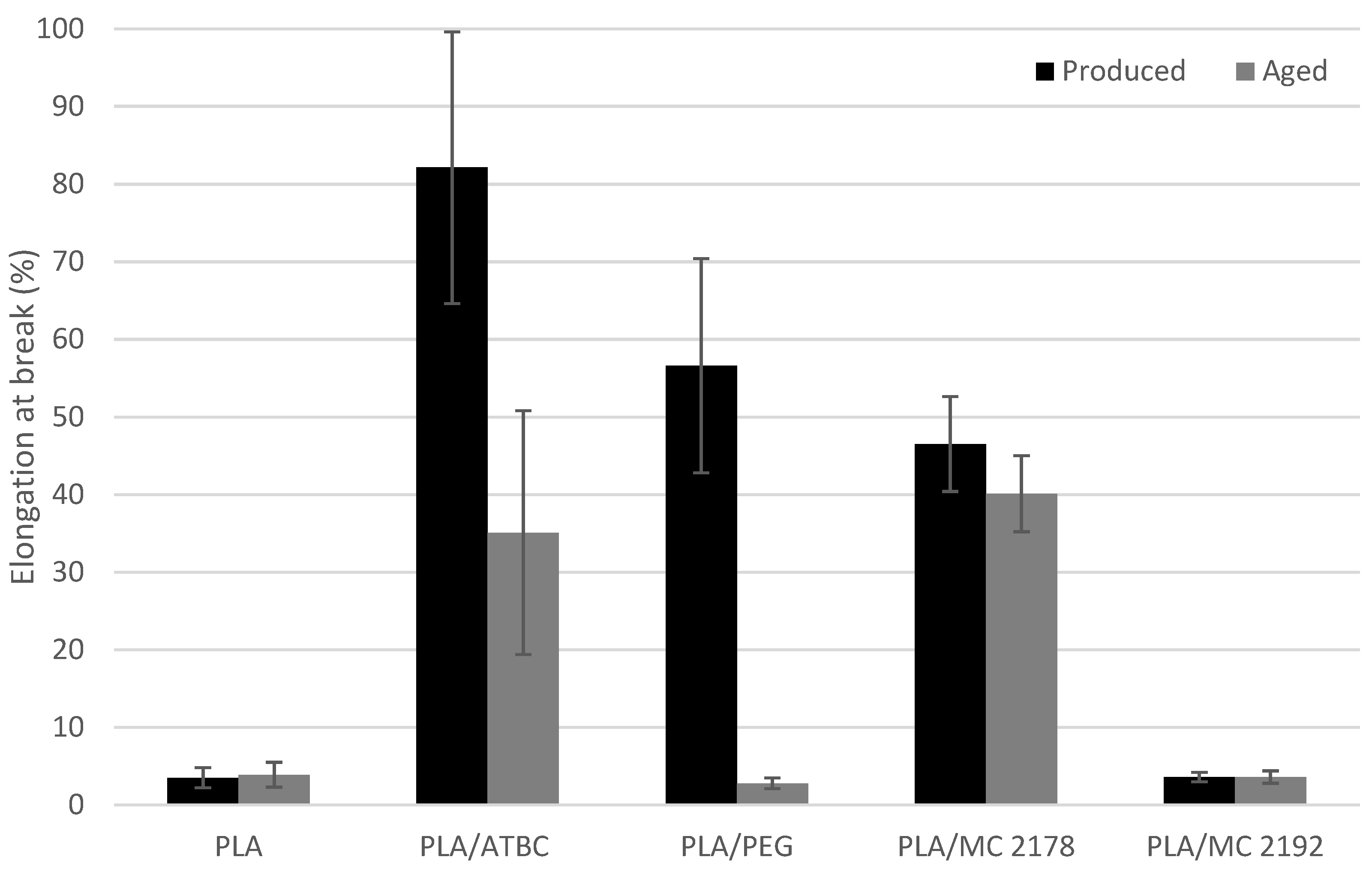
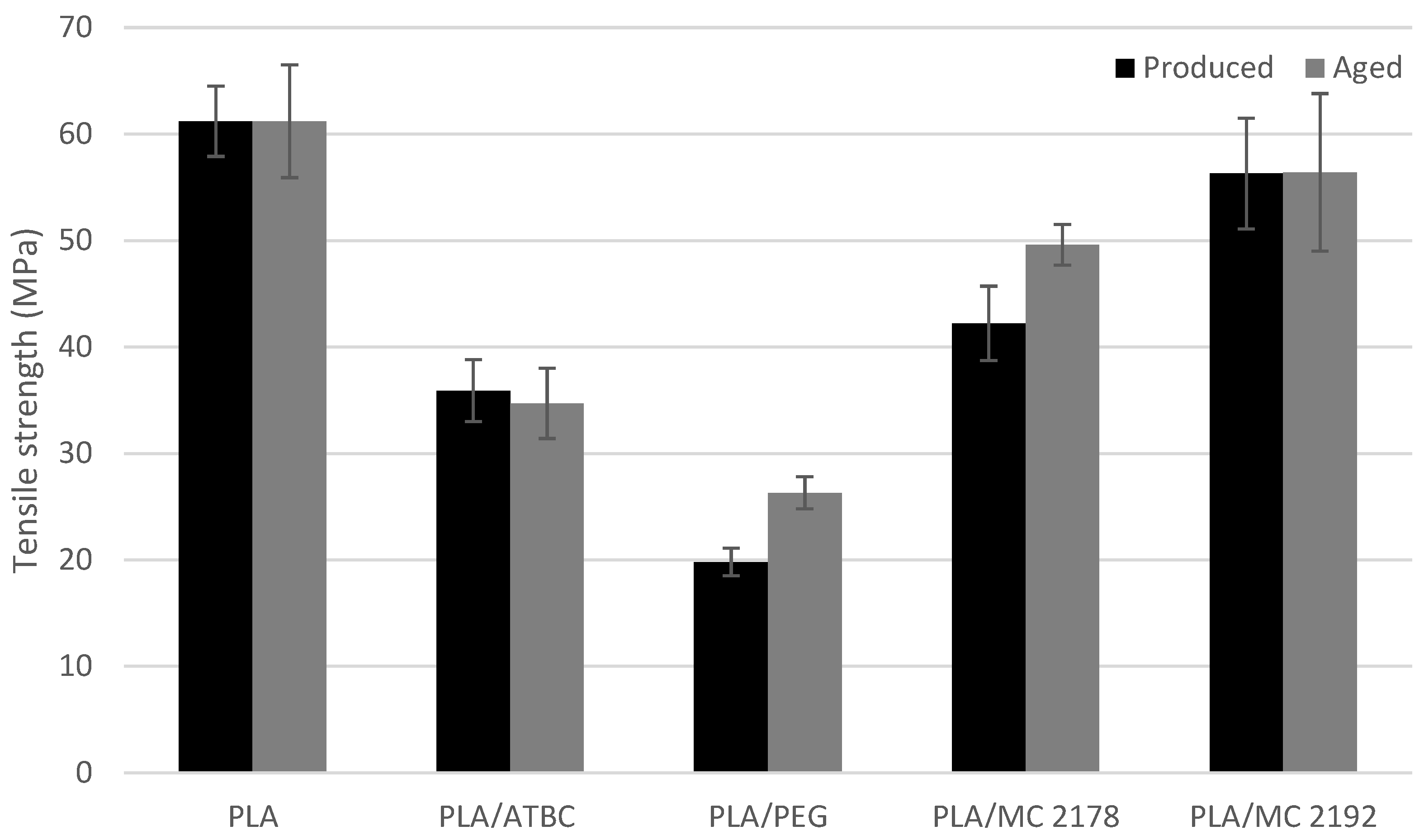
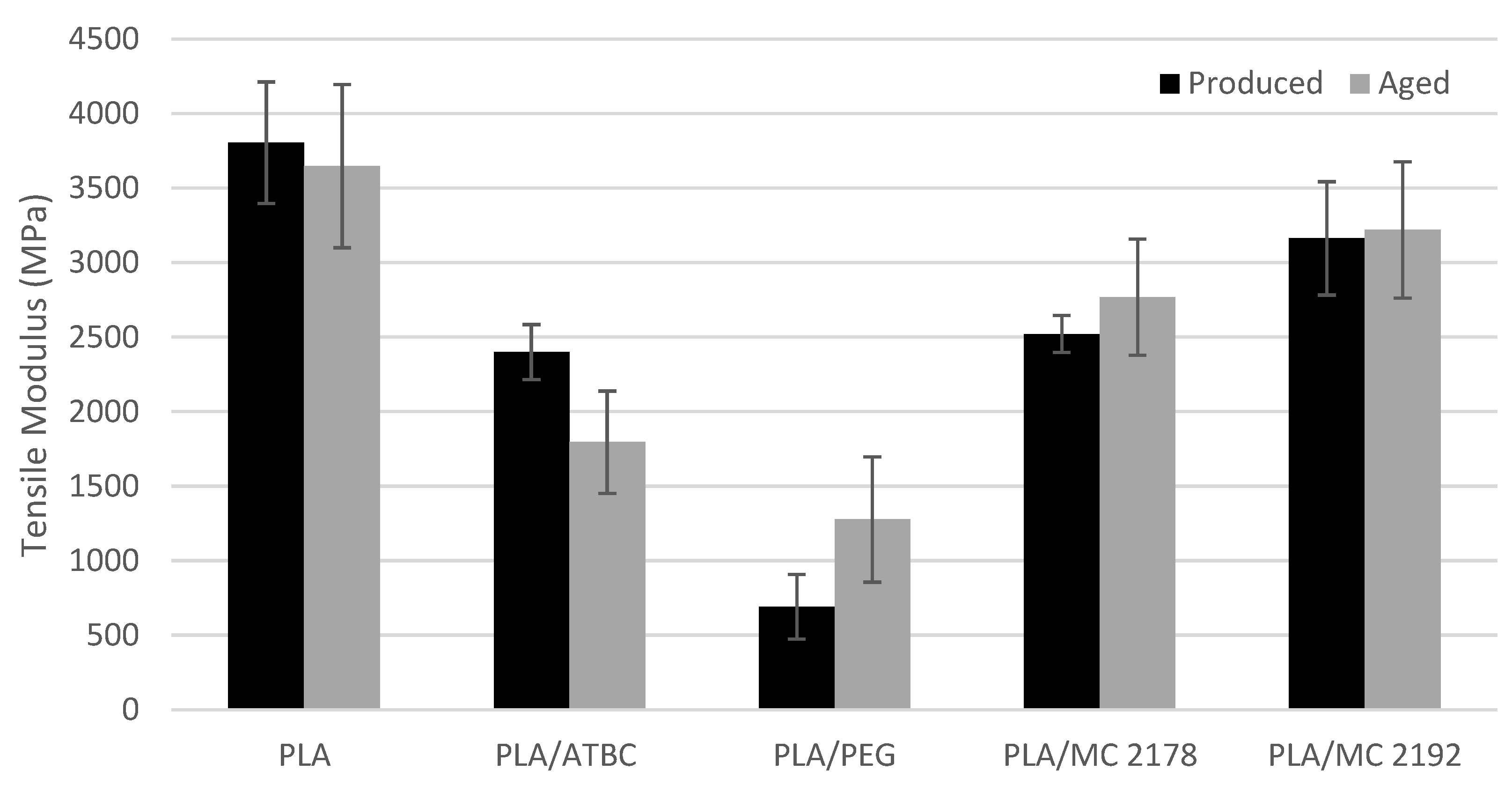
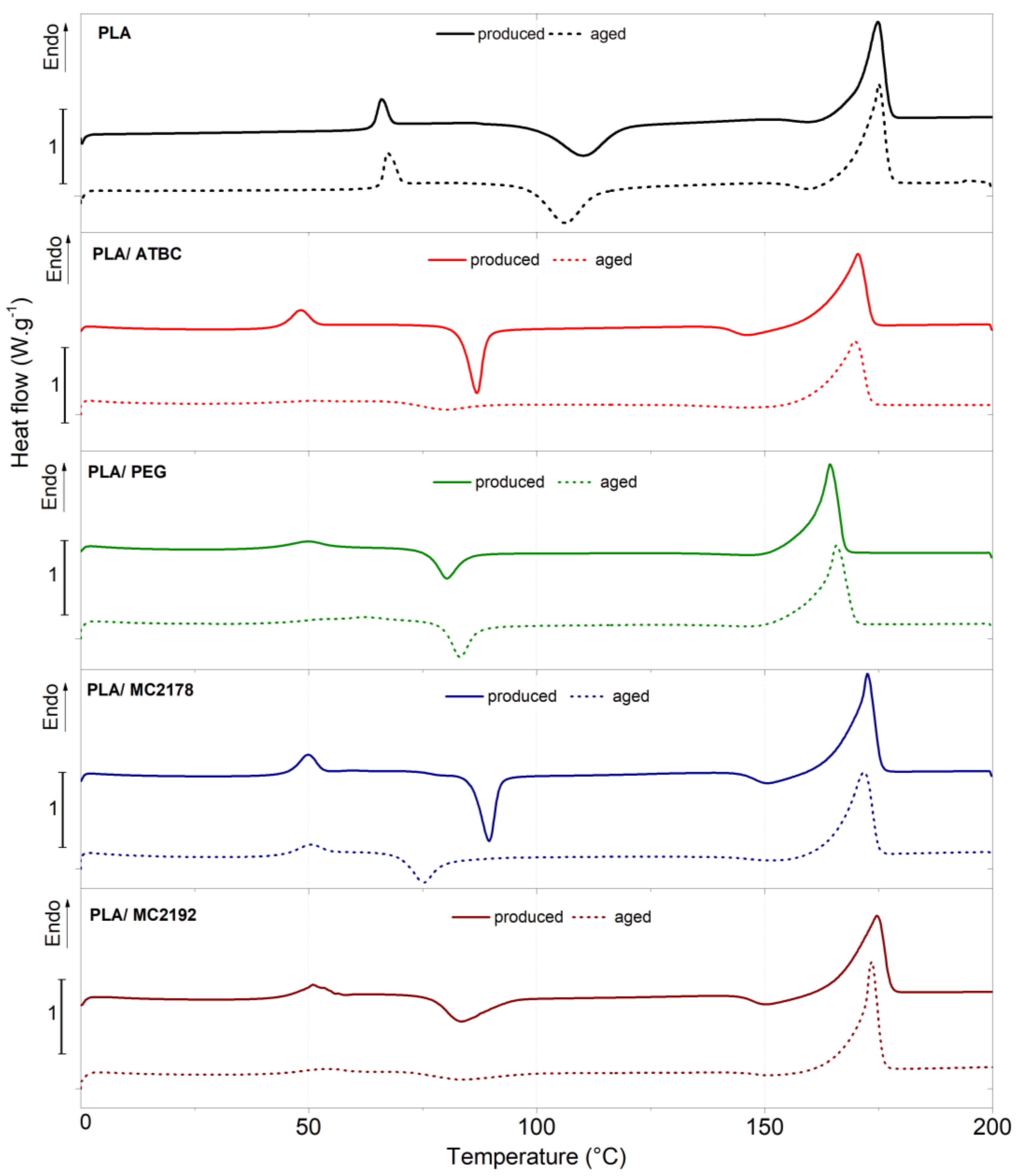

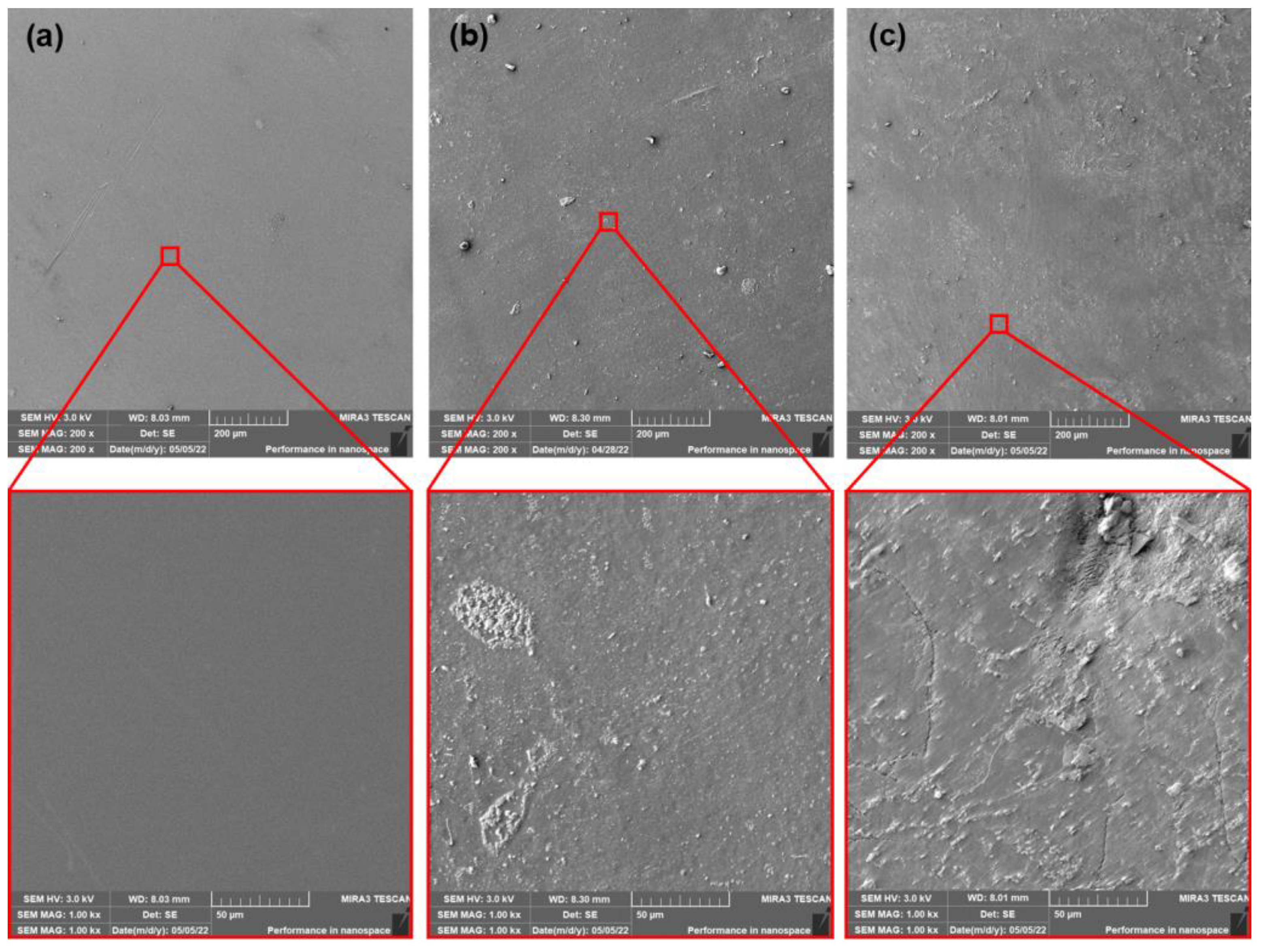
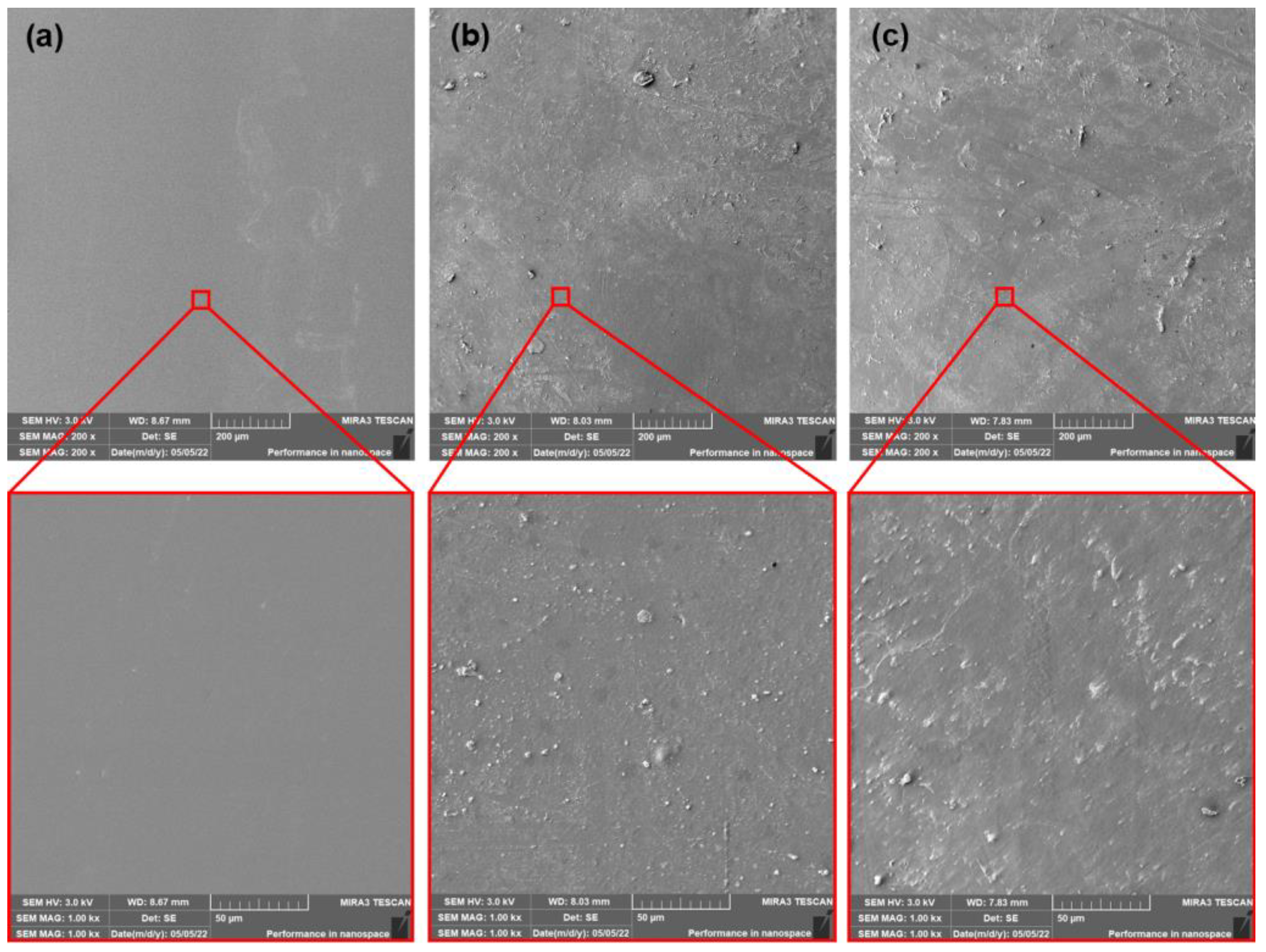
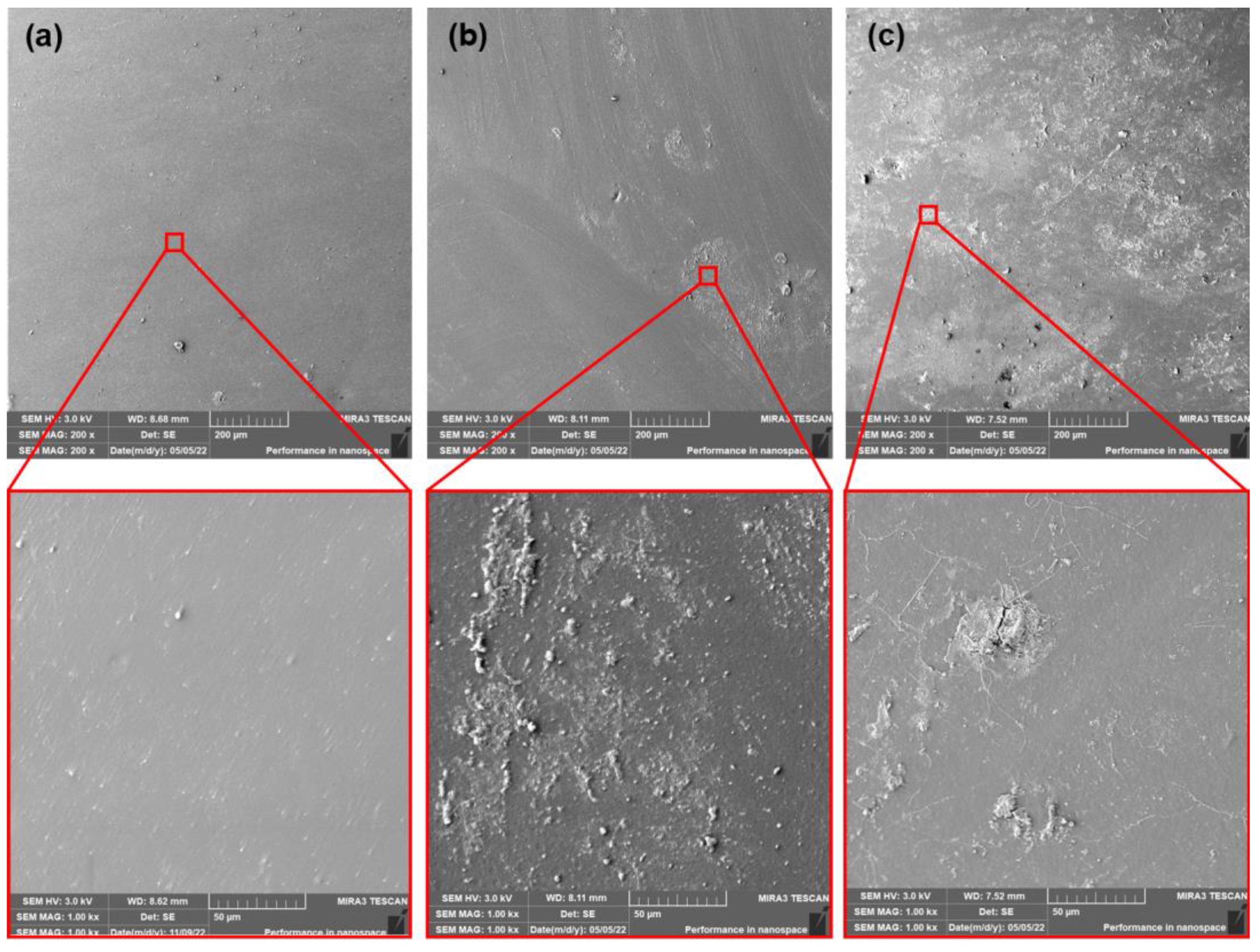
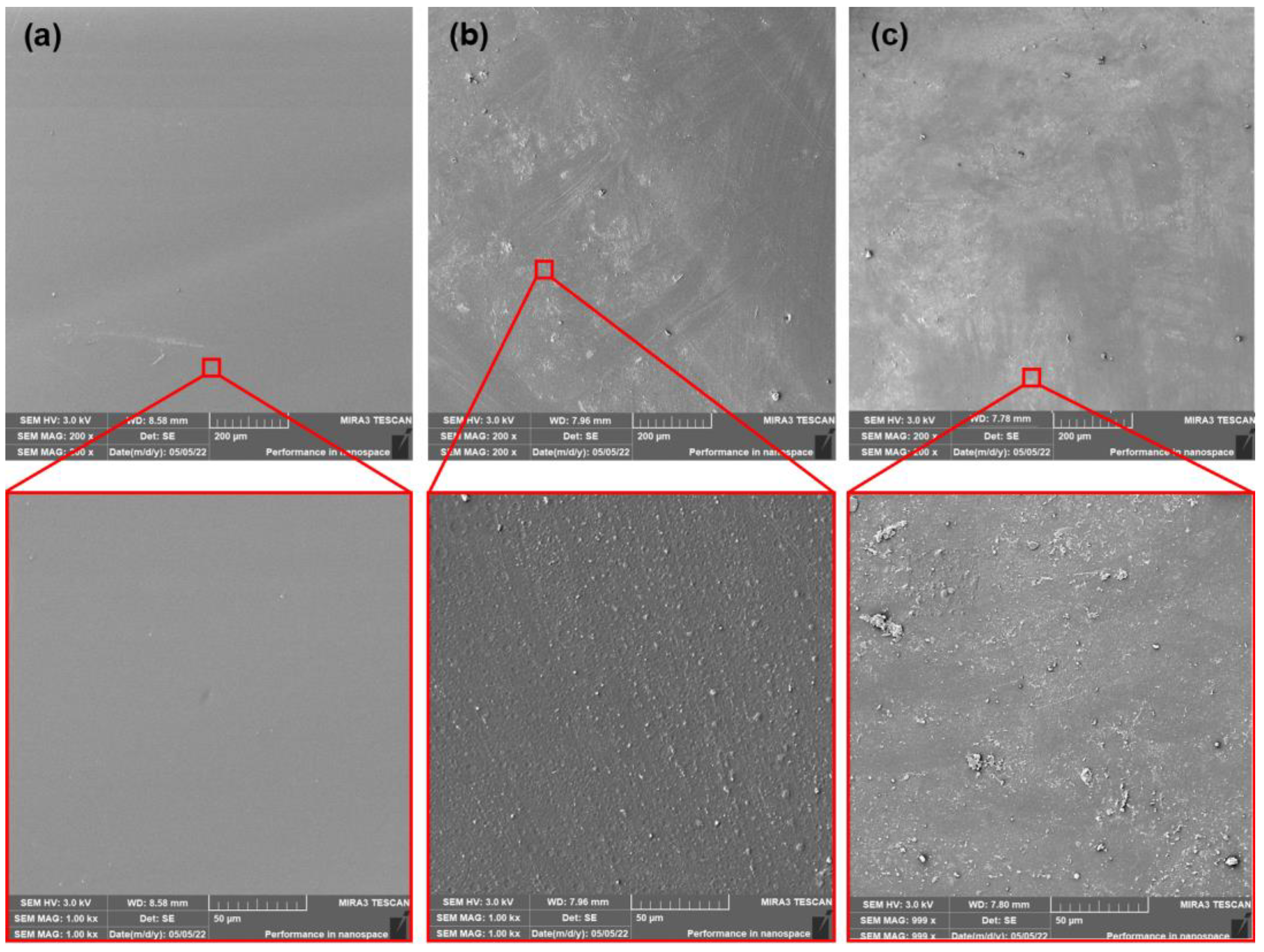

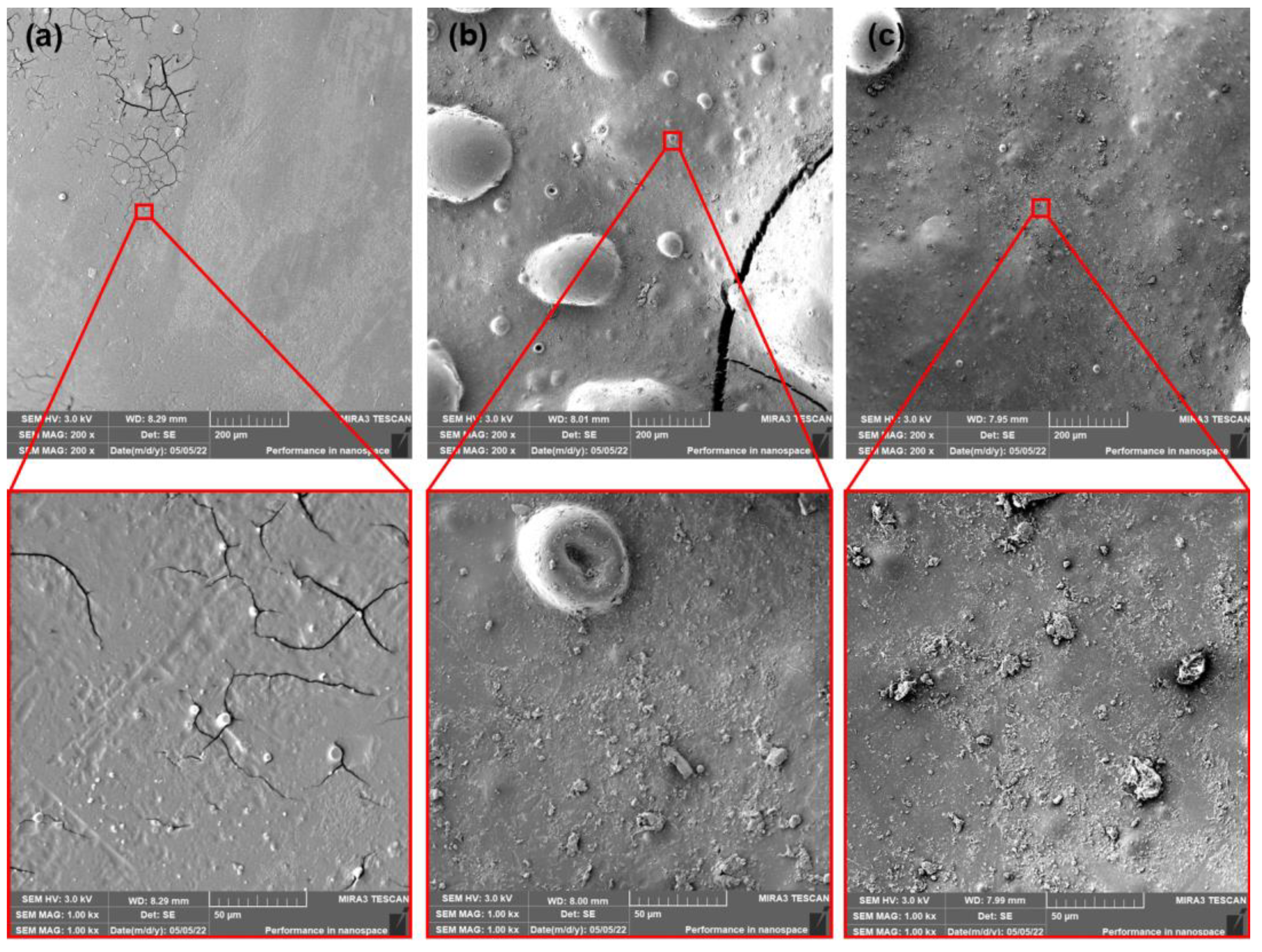
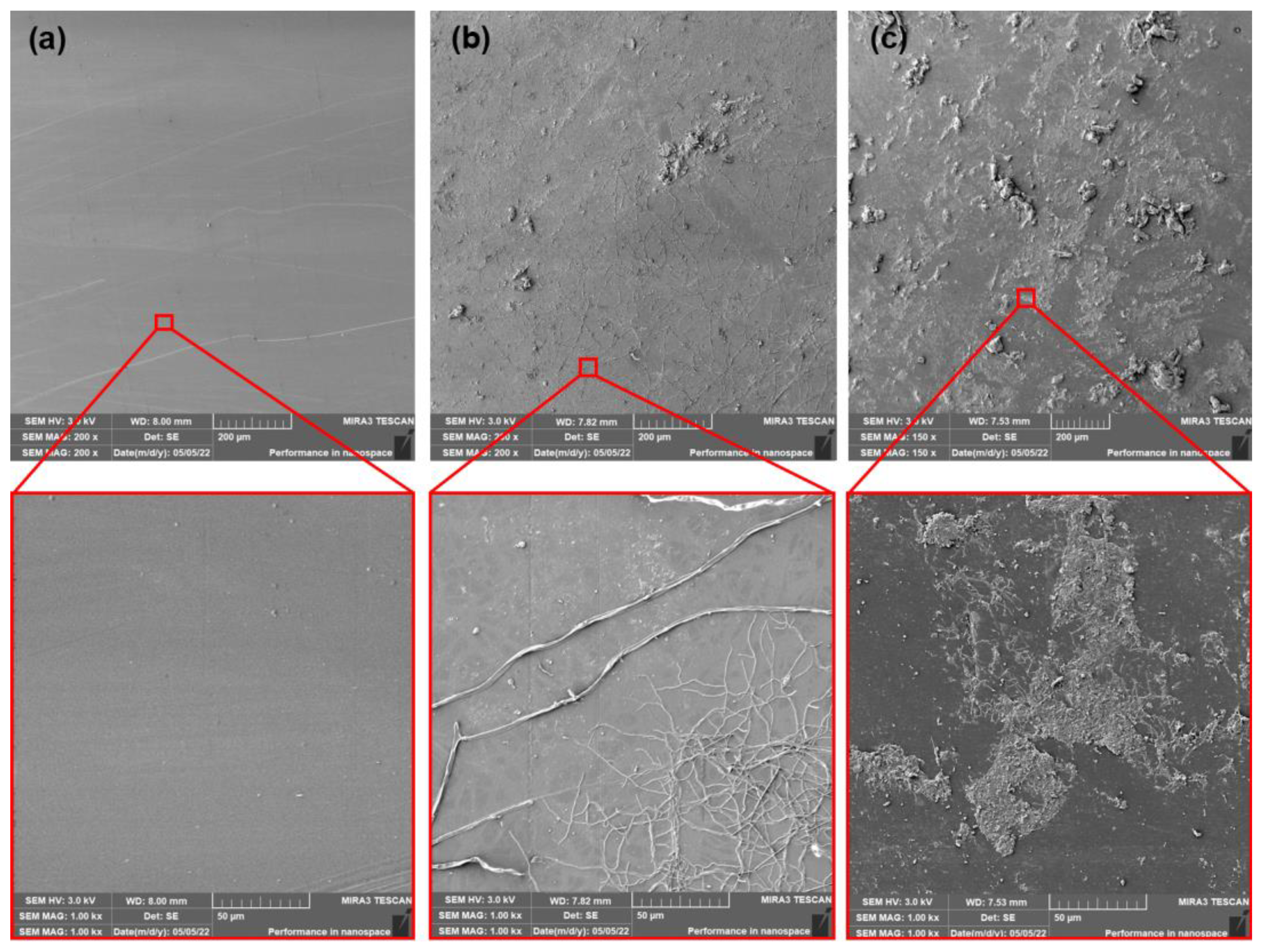

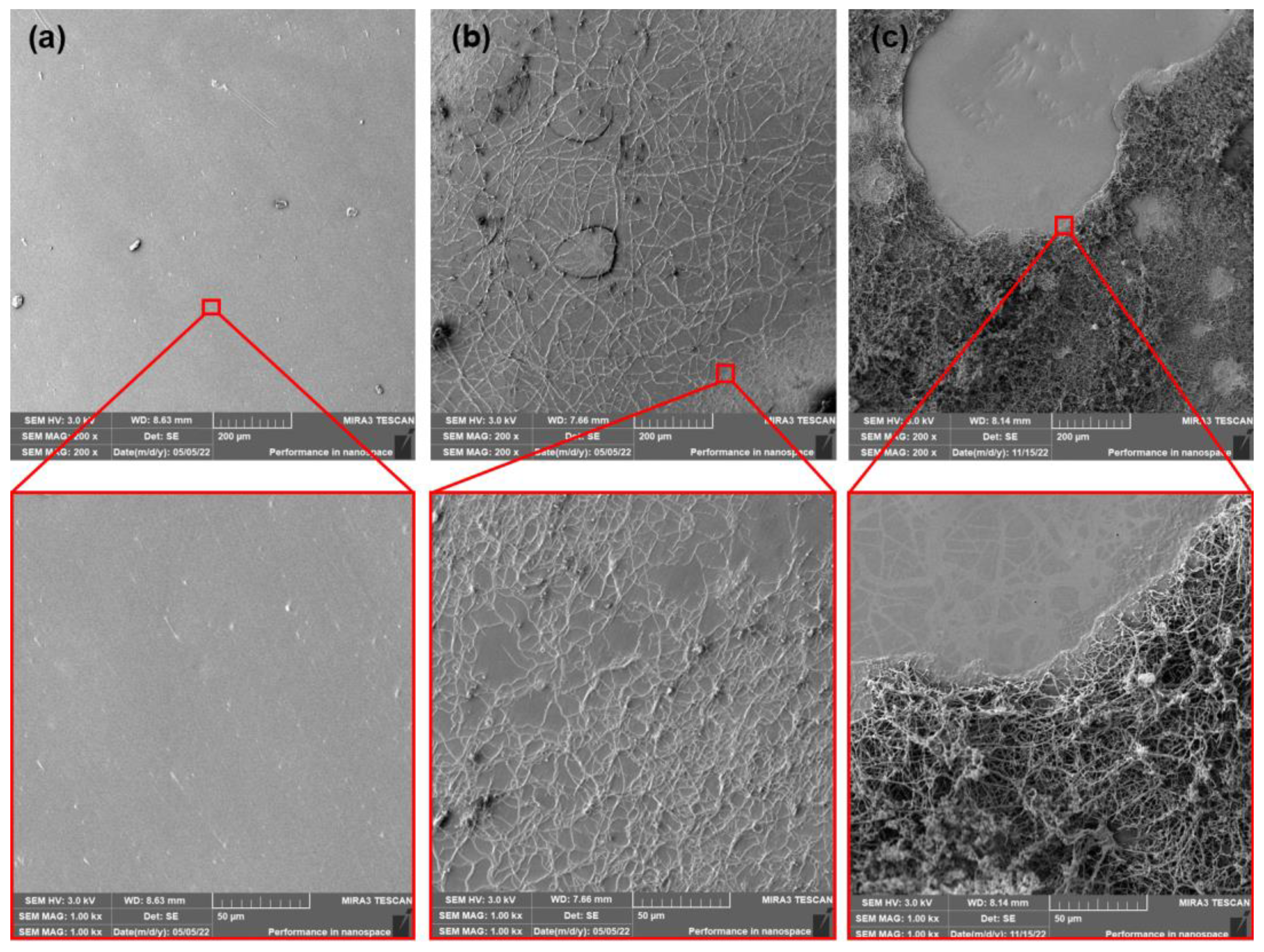

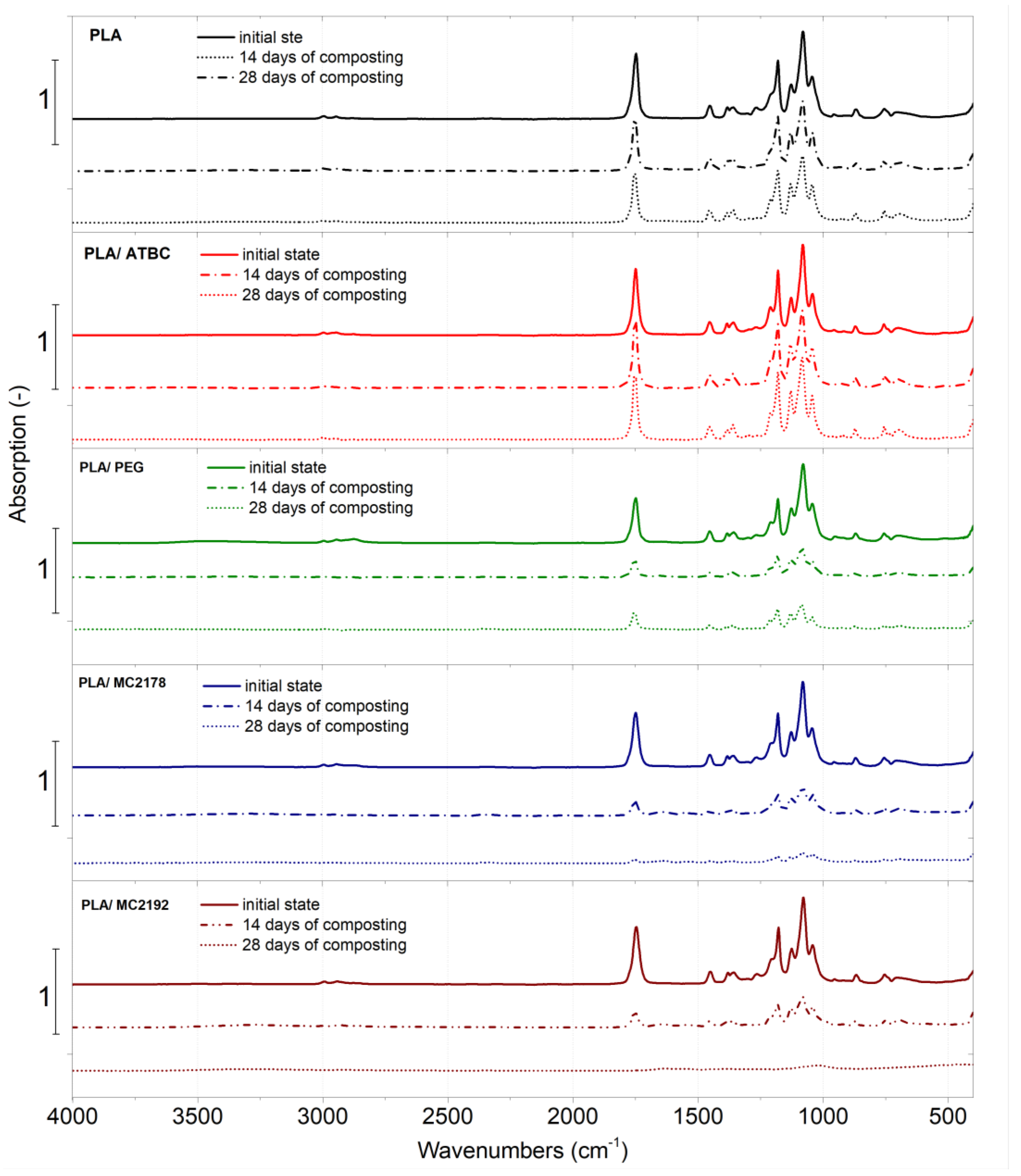
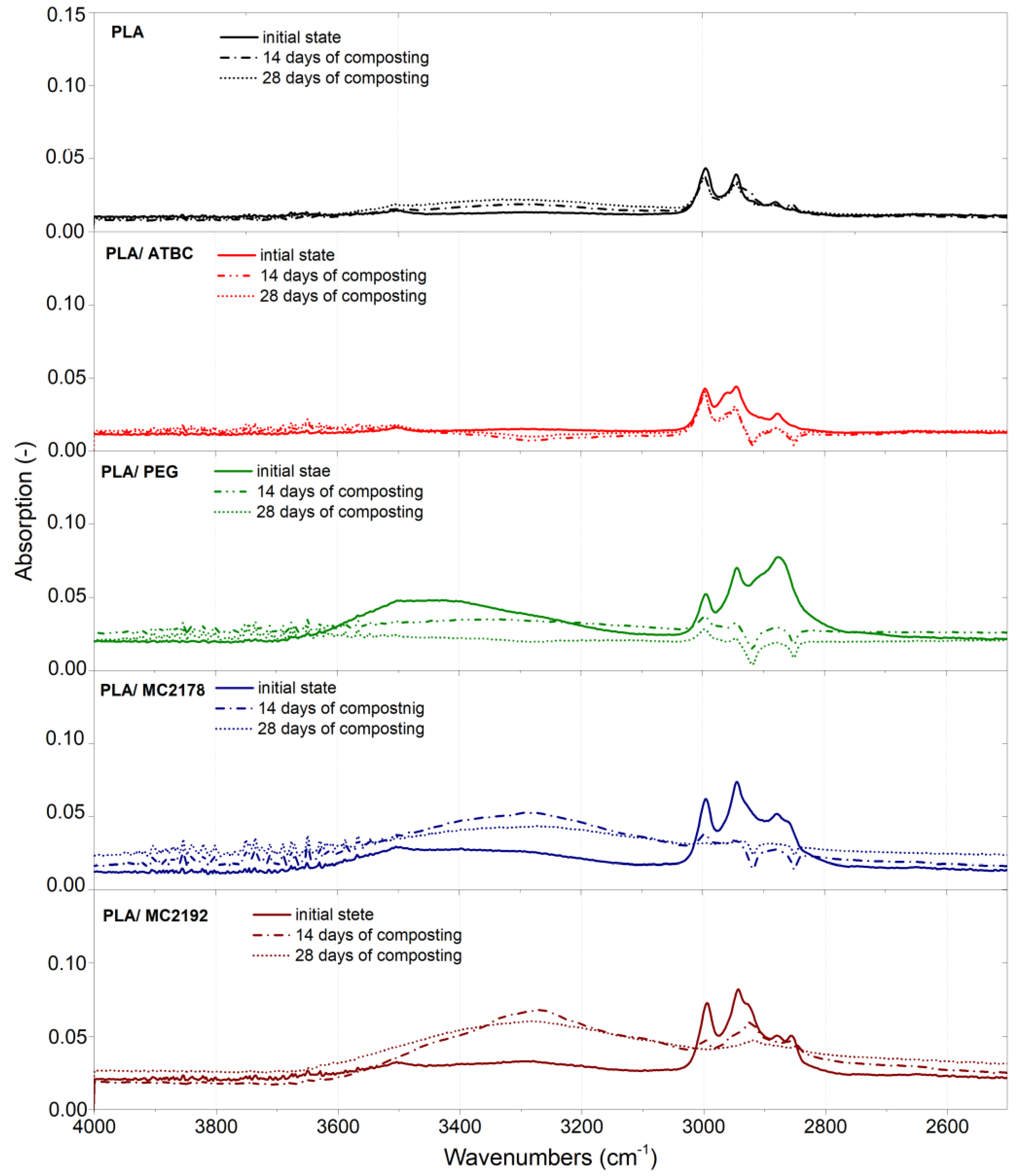

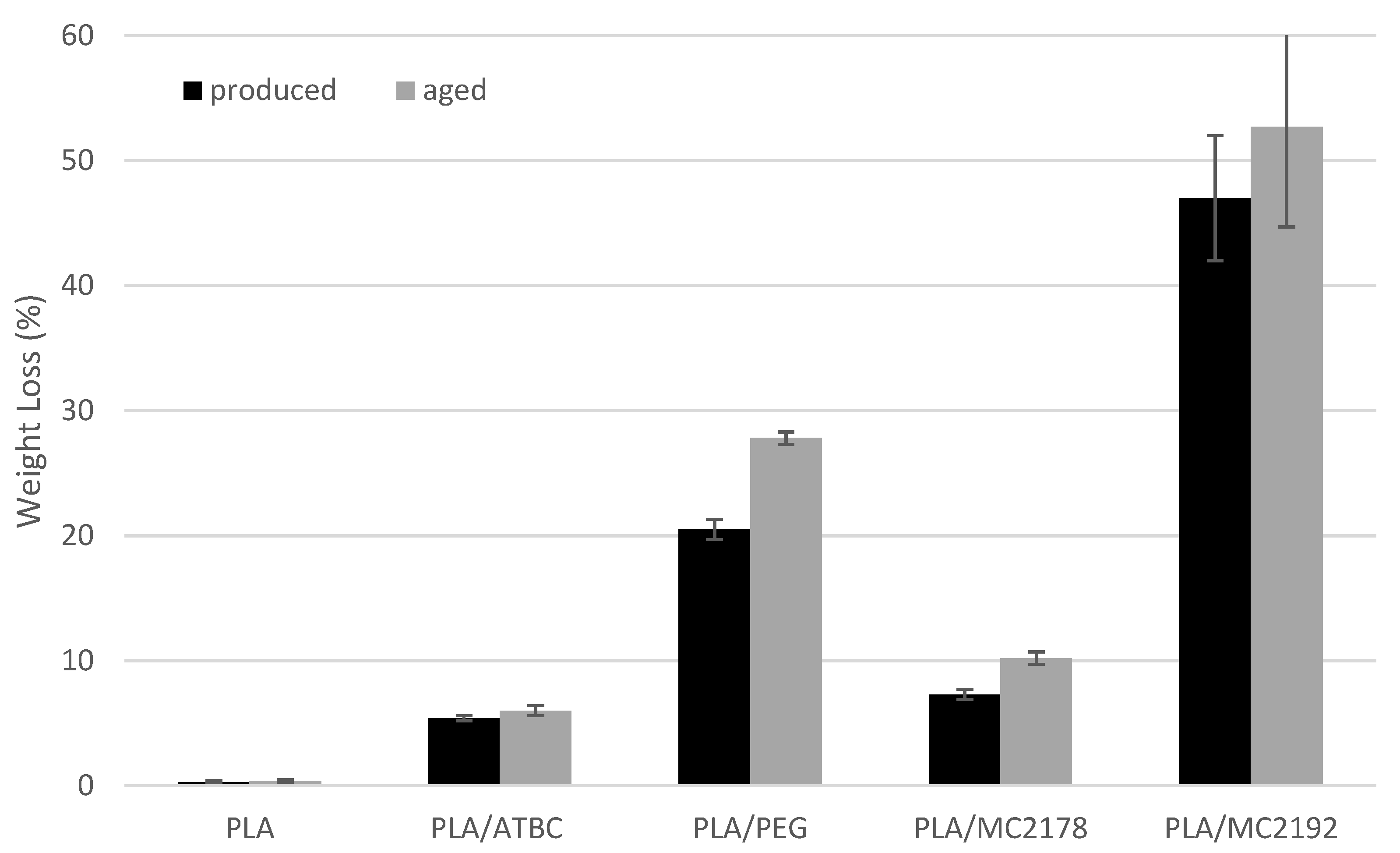
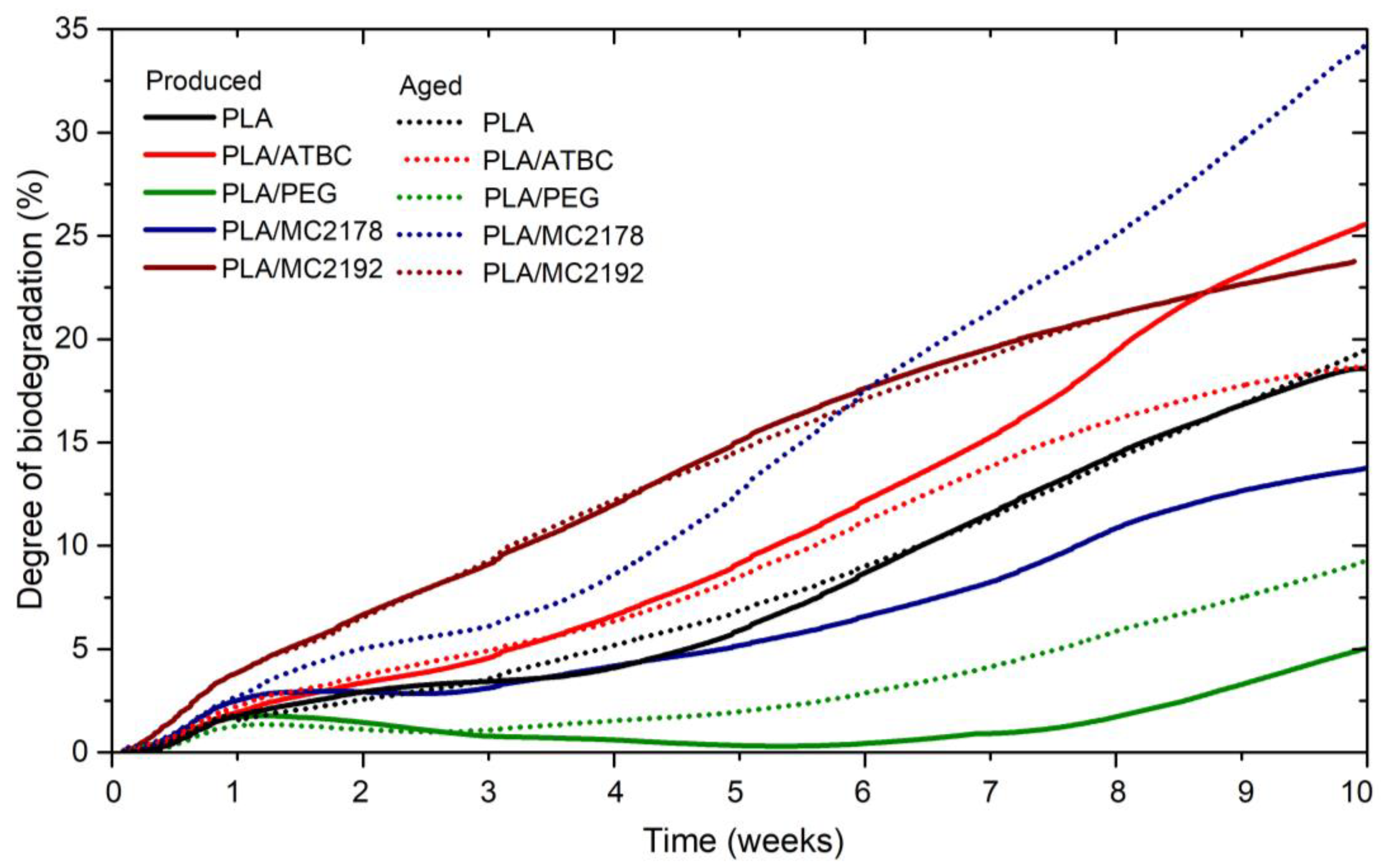
| Plasicizers | Molecular Mass (g∙mol−1) | Density (kg/m3) | Viscosity (mPas) | Sources |
|---|---|---|---|---|
| PEG 400 | 380–420 | 1.125 (at 20 °C) | 30–45 (at 25 °C) | [23,24,25] |
| ATBC citroflex A4 | 402 | 1.048 (at 25 °C) | 53.7 (at 25 °C) | [25,26,27] |
| MC 2178 | 1250 | 1.03–1.07 (at 20 °C) | 650–750 (at 20 °C) | [28] |
| MC 2192 | 4236 | 1.04–1.10 (at 20 °C) | 4000–6000 (at 20 °C) | [29] |
| Sample Designation | Proportions (%) |
|---|---|
| PLA | 50 |
| ATBC citroflex A1 | 59.7 |
| PEG 400 | 60.0 |
| MC2178 | 58.5 |
| MC2192 | 58.5 |
| MVR (cm3/min−1) | Sample Designation | ||||
|---|---|---|---|---|---|
| PLA | PLA/ ATBC | PLA/ PEG 400 | PLA/ MC 2178 | PLA/ MC 2192 | |
| Produced | 13.9 ± 0.5 | 30.7 ± 0.1 | 3076 ± 216 | 23.9 ± 0.4 | 20.7 ± 0.1 |
| Aged | 14.5 ± 0.5 | 35.4 ± 0.1 | 1784 ± 43 | 32.0 ± 0.5 | 30.1 ± 0.4 |
| Sample Designation | Exposition Time of Composting | Tg (°C) | Tcc (°C) | ∆Hcc (J/g) | ∆Hc (J/g) | Tc (°C) | Tm (°C) | ∆Hm (J/g) | ∆H (J/g) | XC (%) | |
|---|---|---|---|---|---|---|---|---|---|---|---|
| PLA | Produced | Initial | 60.3 | 109.2 | 33.6 | 1.5 | 158.6 | 174.1 | 42.1 | 7.0 | 6.6 |
| 14 days | 59.8 | - | - | 1.4 | 161.9 | 175.4 | 51.3 | 49.9 | 47.0 | ||
| 28 days | 54.3 | - | - | - | - | 164.0 | 59.9 | 59.9 | 56.5 | ||
| Aged | Initial | 60.1 | 106.3 | 33.2 | 2.3 | 159.4 | 174.8 | 41.7 | 5.4 | 5.1 | |
| 14 days | 59.4 | - | - | 2.0 | 160.8 | 172.0 | 42.2 | 40.2 | 38.0 | ||
| 28 days | 54.5 | - | - | - | - | 165.5 | 59.7 | 59.7 | 56.3 | ||
| PLA/ ATBC | Produced | Initial | 41.7 | 86.4 | 23.8 | 6.4 | 146.6 | 171.3 | 42.7 | 12.5 | 13.9 |
| 14 days | 46.2 | - | - | 3.2 | 153.4 | 172.2 | 46.6 | 43.4 | - | ||
| 28 days | - | - | - | - | - | 170.4 | 49.4 | 49.4 | - | ||
| Aged | Initial | 40.8 | 80.2 | 7.5 | 2.9 | 146.4 | 170.8 | 39.1 | 28.7 | - | |
| 14 days | 44.9 | - | - | 2.3 | 160.8 | 172.1 | 41.7 | 39.4 | - | ||
| 28 days | - | - | - | - | - | 169.6 | 50.9 | 50.9 | - | ||
| PLA/ PEG | Produced | Initial | 37.6 | 84.1 | 13.4 | 1.7 | - | 167.9 | 41.3 | 26.26 | 29.5 |
| 14 days | 48.8 | - | - | - | - | 173.0 | 47.7 | 47.7 | - | ||
| 28 days | - | - | - | - | - | 172.0 | 48.0 | 48.0 | - | ||
| Aged | Initial | 46.1 | 83.2 | 16.6 | 1.3 | - | 166.0 | 41.9 | 24.0 | - | |
| 14 days | - | 93.9 | 6.9 | - | - | 168.8 | 50.9 | 44.0 | - | ||
| 28 days | - | - | - | - | - | 166.7 | 53.1 | 53.1 | - | ||
| PLA/ MC 2178 | Produced | Initial | 40.1 | 89.5 | 22.8 | 5.0 | 150.7 | 172.5 | 44.3 | 20.9 | 18.2 |
| 14 days | - | - | - | 1.7 | 159.9 | 176.3 | 46.2 | 44.4 | - | ||
| 28 days | - | - | - | - | - | 168.8 | 55.5 | 55.4 | - | ||
| Aged | Initial | 43.2 | 75.6 | 17.1 | 3.4 | 153.6 | 172.5 | 41.2 | 20.7 | - | |
| 14 days | - | - | - | - | - | 172.0 | 46.8 | 46.8 | - | ||
| 28 days | - | - | - | - | - | 169.6 | 55.9 | 55.8 | - | ||
| PLA/ MC2192 | Produced | Initial | 52.8 | 87.6 | 26.2 | 7.1 | 152.1 | 175.5 | 44.2 | 11.0 | 12.6 |
| 14 days | - | - | - | - | - | 163.4 | 59.2 | 59.2 | - | ||
| 28 days | - | - | - | - | - | 156.7 | 63.8 | 63.8 | - | ||
| Aged | Initial | 51.5 | 80.6 | 26.4 | 5.9 | 151.1 | 174.4 | 45.5 | 13.2 | - | |
| 14 days | - | - | - | - | - | 161.2 | 55.5 | 55.5 | - | ||
| 28 days | - | - | - | - | - | 156.8 | 60.6 | 60.6 | - |
| Sample Designation | Exposition Time of Composting | |||||
|---|---|---|---|---|---|---|
| Initial State | 14 Days | 28 Days | ||||
| T5 (%) | T50 (%) | T5% (%) | T50 (%) | T5 (%) | T50 (%) | |
| Produced PLA | 313.4 | 349.9 | 310.9 | 342.5 | 293.9 | 330.6 |
| Aged PLA | 315.8 | 352.5 | 306.9 | 335.0 | 288.8 | 351.7 |
| Produced PLA/ATBC | 310.5 | 349.0 | 293.8 | 344.8 | 276.9 | 335.7 |
| Aged PLA/ATBC | 301.6 | 356.7 | 292.0 | 341.2 | 273.3 | 329.3 |
| Produced PLA/PEG 400 | 259.4 | 321.7 | 250.4 | 301.6 | 244.1 | 282.9 |
| Aged PLA/PEG 400 | 296.8 | 348.5 | 280.9 | 332.3 | 250.6 | 300.7 |
| Produced PLA/MC2178 | 297.9 | 355.8 | 295.1 | 340.4 | 283.7 | 340.1 |
| Aged PLA/MC2178 | 308.5 | 353.0 | 293.11 | 338.4 | 272.9 | 331.3 |
| Produced PLA/MC2192 | 309.6 | 357.0 | 299.1 | 350.1 | 254.3 | 305.7 |
| Aged PLA/MC2192 | 311.8 | 356.1 | 297.3 | 350.1 | 257.6 | 305.3 |
Disclaimer/Publisher’s Note: The statements, opinions and data contained in all publications are solely those of the individual author(s) and contributor(s) and not of MDPI and/or the editor(s). MDPI and/or the editor(s) disclaim responsibility for any injury to people or property resulting from any ideas, methods, instructions or products referred to in the content. |
© 2022 by the authors. Licensee MDPI, Basel, Switzerland. This article is an open access article distributed under the terms and conditions of the Creative Commons Attribution (CC BY) license (https://creativecommons.org/licenses/by/4.0/).
Share and Cite
Brdlík, P.; Novák, J.; Borůvka, M.; Běhálek, L.; Lenfeld, P. The Influence of Plasticizers and Accelerated Ageing on Biodegradation of PLA under Controlled Composting Conditions. Polymers 2023, 15, 140. https://doi.org/10.3390/polym15010140
Brdlík P, Novák J, Borůvka M, Běhálek L, Lenfeld P. The Influence of Plasticizers and Accelerated Ageing on Biodegradation of PLA under Controlled Composting Conditions. Polymers. 2023; 15(1):140. https://doi.org/10.3390/polym15010140
Chicago/Turabian StyleBrdlík, Pavel, Jan Novák, Martin Borůvka, Luboš Běhálek, and Petr Lenfeld. 2023. "The Influence of Plasticizers and Accelerated Ageing on Biodegradation of PLA under Controlled Composting Conditions" Polymers 15, no. 1: 140. https://doi.org/10.3390/polym15010140
APA StyleBrdlík, P., Novák, J., Borůvka, M., Běhálek, L., & Lenfeld, P. (2023). The Influence of Plasticizers and Accelerated Ageing on Biodegradation of PLA under Controlled Composting Conditions. Polymers, 15(1), 140. https://doi.org/10.3390/polym15010140







